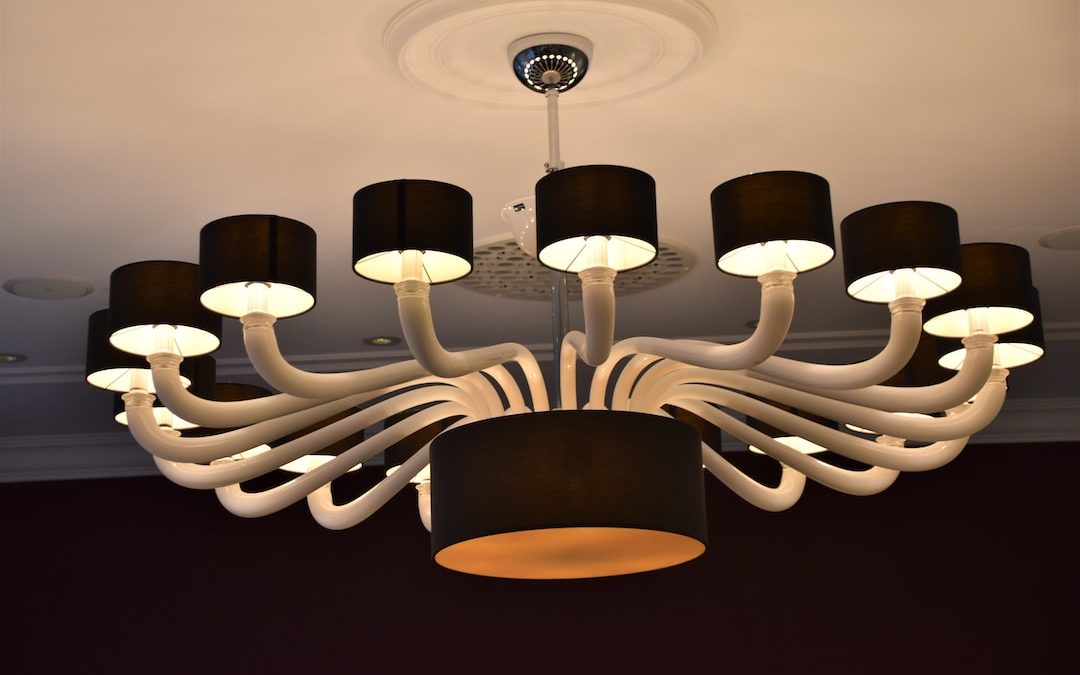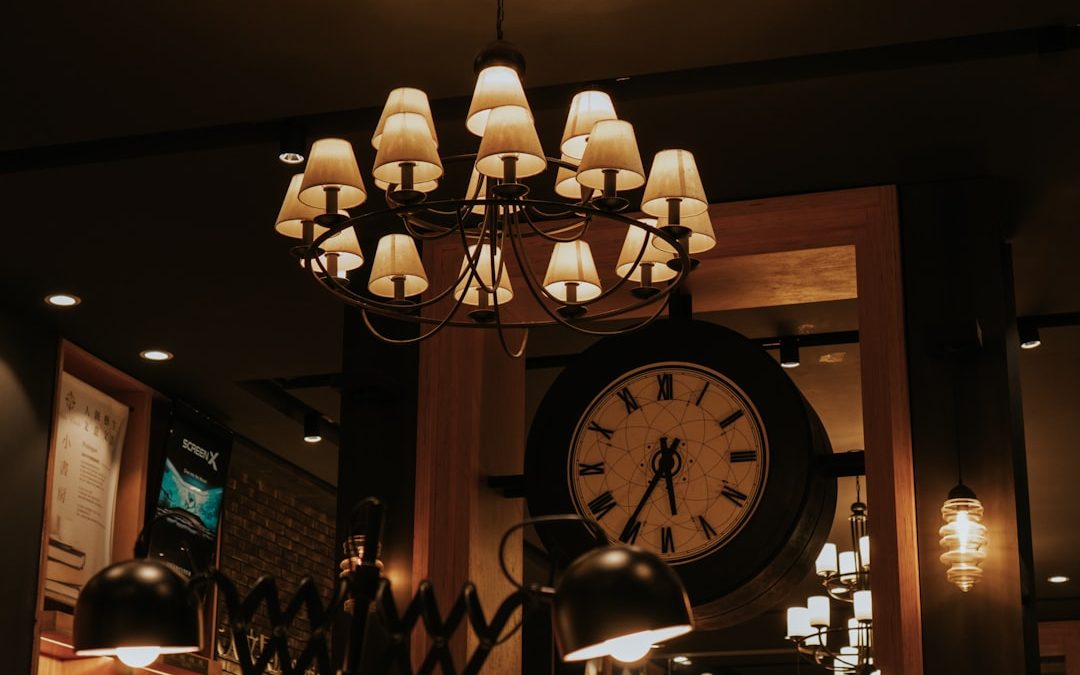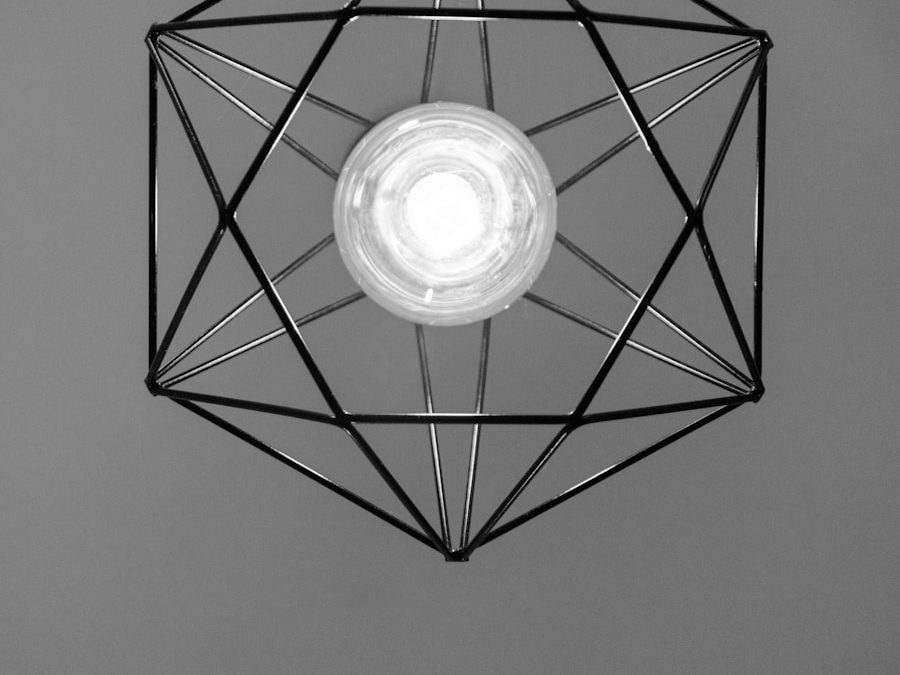
Light up your Space with Stylish Ceiling Lamps: A Guide to Choosing the Perfect Fixture
Ceiling lamps play a crucial role in interior design, as they not only provide illumination but also contribute to the overall aesthetic of a space. The right ceiling lamp can enhance the mood and ambiance of a room, creating a warm and inviting atmosphere. Whether you’re looking to add a touch of elegance with a chandelier or create a modern and minimalist look with pendant lights, choosing the right ceiling lamp is essential for achieving your desired design aesthetic.
Lighting has a significant impact on the overall feel of a room. It can make a space feel cozy and intimate or bright and energetic. The right lighting can highlight architectural features, artwork, or furniture, while also providing functional illumination for everyday tasks. Ceiling lamps are particularly important as they provide overhead lighting that evenly distributes light throughout the room. This helps to eliminate shadows and create a well-lit space that is both visually appealing and functional.
Types of Ceiling Lamps: From Chandeliers to Pendant Lights
When it comes to ceiling lamps, there are various types to choose from, each with its own unique style and functionality. Chandeliers are often seen as a statement piece, adding elegance and sophistication to any room. They come in various sizes and designs, from traditional crystal chandeliers to more modern and minimalist styles.
Pendant lights are another popular choice for ceiling lamps. They are versatile and can be used in various spaces, from kitchens to dining rooms to bedrooms. Pendant lights hang down from the ceiling by a cord or chain and come in a wide range of styles, shapes, and sizes. They can be used as a single statement piece or grouped together for a more dramatic effect.
Flush mount and semi-flush mount ceiling lamps are ideal for rooms with low ceilings or limited space. These types of lamps sit close to the ceiling and provide ample light without taking up too much visual space. They are available in a variety of styles, from traditional to modern, making them suitable for any design aesthetic.
Choosing the Right Size: How to Determine the Best Fit for Your Room
Choosing the right size ceiling lamp is crucial for achieving a balanced and visually appealing look in your space. There are several factors to consider when determining the size of your ceiling lamp.
First, consider the size of the room. A larger room will require a larger ceiling lamp to provide adequate lighting. On the other hand, a smaller room may be overwhelmed by a large, statement-making chandelier. It’s important to find a balance between the size of the room and the size of the ceiling lamp.
Next, consider the height of the ceiling. For rooms with high ceilings, you can opt for a larger ceiling lamp that will make a bold statement. However, if you have low ceilings, it’s best to choose a flush mount or semi-flush mount ceiling lamp that sits close to the ceiling and doesn’t hang down too far.
Lastly, consider the scale of your furniture and other decor items in the room. Your ceiling lamp should complement the overall design aesthetic and not overpower or clash with other elements in the space. Take measurements of your furniture and consider how the ceiling lamp will fit in with the rest of your decor.
Materials and Finishes: Exploring the Options for Ceiling Lamp Design
Ceiling lamps come in a wide range of materials and finishes, allowing you to choose one that suits your personal style and complements your existing decor. Some common materials used for ceiling lamps include metal, glass, crystal, and fabric.
Metal ceiling lamps are popular for their durability and versatility. They can be found in various finishes such as brushed nickel, bronze, or brass, allowing you to match them with other metal accents in your space. Metal lamps can range from sleek and modern to ornate and traditional, making them suitable for any design aesthetic.
Glass and crystal ceiling lamps add a touch of elegance and sophistication to any room. They can create a beautiful play of light and shadows, adding visual interest to the space. Glass lamps can be clear or frosted, while crystal lamps often feature intricate designs and sparkling accents.
Fabric ceiling lamps are a great option for adding texture and softness to a room. They can be made from various fabrics such as linen, silk, or cotton, and come in a range of colors and patterns. Fabric lamps are often used in bedrooms or living rooms to create a cozy and inviting atmosphere.
When choosing the material and finish for your ceiling lamp, consider the overall style of your space and how the lamp will fit in with your existing decor. It’s important to choose a lamp that complements the other elements in the room and creates a cohesive look.
Light Bulb Options: LED, Incandescent, and More
The type of light bulb you choose for your ceiling lamp can have a significant impact on both the quality of light and energy efficiency. There are several options to consider, each with its own pros and cons.
LED (Light Emitting Diode) bulbs are becoming increasingly popular due to their energy efficiency and long lifespan. LED bulbs use less energy than traditional incandescent bulbs and can last up to 25 times longer. They also produce less heat, making them safer to use. LED bulbs come in various color temperatures, allowing you to choose between warm white, cool white, or daylight depending on your preference.
Incandescent bulbs are the traditional choice for lighting fixtures. They produce a warm and soft light that is often preferred for creating a cozy atmosphere. However, incandescent bulbs are not as energy-efficient as LED bulbs and have a shorter lifespan.
Compact Fluorescent Lamps (CFLs) are another energy-efficient option. They use less energy than incandescent bulbs and can last up to 10 times longer. CFLs produce a bright and cool light, making them suitable for task lighting or areas where a lot of light is needed.
Halogen bulbs are similar to incandescent bulbs but are more energy-efficient. They produce a bright and white light that is often used for task lighting or accent lighting. Halogen bulbs have a longer lifespan than incandescent bulbs but are not as energy-efficient as LED or CFL bulbs.
When choosing a light bulb for your ceiling lamp, consider the desired level of brightness, color temperature, and energy efficiency. LED bulbs are often the recommended choice for their long lifespan and energy-saving benefits.
Style Considerations: Matching Your Ceiling Lamp to Your Decor

When choosing a ceiling lamp, it’s important to consider the overall style of your space and how the lamp will fit in with your existing decor. A well-chosen ceiling lamp can enhance the aesthetic of a room and create a cohesive look.
If you have a traditional or classic design aesthetic, consider choosing a chandelier with ornate details and crystal accents. This will add elegance and sophistication to the space. For a more modern or minimalist look, opt for pendant lights with clean lines and simple designs. Pendant lights made from metal or glass can create a sleek and contemporary feel.
Consider the color scheme of your space when choosing a ceiling lamp. If you have neutral or monochromatic colors, you can choose a lamp that adds a pop of color or acts as a focal point. On the other hand, if you have bold or vibrant colors in your space, it’s best to choose a ceiling lamp that complements the existing color palette.
It’s also important to consider the scale and proportion of your ceiling lamp in relation to other elements in the room. A large chandelier may overpower a small dining room, while a small pendant light may get lost in a large living room. Take measurements of your furniture and consider how the ceiling lamp will fit in with the rest of your decor.
Installation Tips: DIY or Professional Help?
When it comes to installing a ceiling lamp, you have the option to do it yourself or hire a professional. Both options have their pros and cons, and the choice depends on your level of comfort and expertise.
DIY installation can be a cost-effective option, as it eliminates the need to hire a professional. If you have experience with electrical work and feel confident in your abilities, you can save money by installing the ceiling lamp yourself. However, it’s important to note that electrical work can be dangerous if not done correctly. It’s crucial to follow all safety precautions and consult an electrician if you have any doubts.
Professional installation ensures that the ceiling lamp is installed correctly and safely. Electricians have the knowledge and expertise to handle electrical wiring and ensure that everything is up to code. Hiring a professional can give you peace of mind knowing that the installation is done properly.
When deciding whether to install a ceiling lamp yourself or hire a professional, consider your level of experience, comfort with electrical work, and the complexity of the installation. If you’re unsure or have any doubts, it’s best to consult a professional.
Maintenance and Cleaning: Keeping Your Ceiling Lamp in Top Condition
To keep your ceiling lamp looking its best and functioning properly, regular maintenance and cleaning are essential. Here are some tips for keeping your ceiling lamp in top condition:
– Dust regularly: Dust can accumulate on the surface of your ceiling lamp, dulling its shine and reducing its brightness. Use a soft cloth or duster to gently remove dust from the lampshade, bulbs, and any other visible surfaces.
– Clean glass or crystal lamps: If you have a glass or crystal ceiling lamp, use a glass cleaner or a mixture of water and vinegar to clean the surfaces. Spray the cleaner onto a soft cloth and gently wipe the glass or crystal. Avoid spraying the cleaner directly onto the lamp, as it can damage the electrical components.
– Check for loose or burnt-out bulbs: Regularly check the bulbs in your ceiling lamp to ensure they are securely in place and functioning properly. Replace any burnt-out bulbs with new ones of the same wattage.
– Inspect the wiring: Periodically inspect the wiring of your ceiling lamp to ensure there are no frayed or damaged wires. If you notice any issues, it’s best to consult a professional electrician for repairs.
– Avoid harsh chemicals: When cleaning your ceiling lamp, avoid using harsh chemicals or abrasive cleaners, as they can damage the finish or electrical components. Stick to mild cleaners and gentle cleaning methods.
Regular maintenance and cleaning will help prolong the lifespan of your ceiling lamp and keep it looking its best. It’s important to follow manufacturer’s instructions and consult a professional if you have any concerns or issues.
Energy Efficiency: Saving Money and the Environment with Ceiling Lamps
Choosing an energy-efficient ceiling lamp not only helps you save money on your energy bills but also reduces your environmental impact. Here are some tips for choosing an energy-efficient ceiling lamp:
– Opt for LED bulbs: LED bulbs are the most energy-efficient option, using up to 80% less energy than traditional incandescent bulbs. They also last significantly longer, reducing the need for frequent bulb replacements.
– Look for ENERGY STAR certified lamps: ENERGY STAR is a program that certifies products that meet strict energy efficiency guidelines. Look for ceiling lamps that are ENERGY STAR certified to ensure they meet high standards of energy efficiency.
– Consider dimmable options: Dimmable ceiling lamps allow you to adjust the brightness according to your needs, reducing energy consumption when full brightness is not required.
– Use timers or motion sensors: Installing timers or motion sensors can help reduce energy consumption by automatically turning off the ceiling lamp when it’s not in use or when there is sufficient natural light.
– Choose the right size: Choosing the right size ceiling lamp for your space ensures that you are not wasting energy on excessive lighting. A properly sized lamp will provide adequate illumination without overusing energy.
By choosing an energy-efficient ceiling lamp, you can reduce your energy consumption, lower your energy bills, and contribute to a more sustainable environment.
Finding the Perfect Ceiling Lamp for Your Home
Choosing the perfect ceiling lamp for your home involves considering various factors such as the type of lamp, size, materials and finishes, light bulb options, style considerations, installation options, maintenance and cleaning, and energy efficiency. By taking the time to carefully consider these factors, you can find a ceiling lamp that not only provides adequate lighting but also enhances the overall aesthetic of your space.
Remember to consider the size of your room and ceiling height when choosing a ceiling lamp. Take measurements and consider how the lamp will fit in with your existing furniture and decor. Choose a material and finish that complements your design aesthetic and consider the type of light bulb that best suits your needs.
Whether you choose to install the ceiling lamp yourself or hire a professional, regular maintenance and cleaning are essential for keeping your lamp in top condition. Consider energy-efficient options to save money on your energy bills and reduce your environmental impact.
By following these tips and considering all aspects of choosing a ceiling lamp, you can find the perfect lighting solution for your home that not only provides functional illumination but also enhances the overall design aesthetic.



